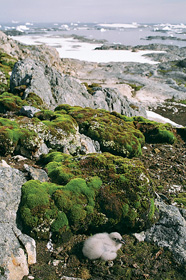Přestože naprostá většina povrchu „bílého kontinentu“ je pokryta mocnou vrstvou ledu a nejeví žádné známky života, najdeme v Antarktidě i četná nezaledněná území. Patří mezi ně i Antarktický poloostrov, kterému bude v tomto seriálu věnována hlavní pozornost. Rozvoj terestrických ekosystémů po ústupu ledovců zde významně ovlivňuje přítomnost ptáků, kteří svými exkrementy obohacují živinami chudé skalní substráty. Díky nim se tu navzdory drsným podmínkám vyvinula zajímavá společenstva rostlin a lišejníků.
Peat H. J., Clarke A. a Convey P. (2007): Diversity and biogeography of the Antarctic flora.
Journal of Biogeography 34: 132-146
Convey P. a Stevens M. I. (2007): Antarctic Biodiversity. Science 317: 1877-1878
Although most of the „White Continent” is covered by a thick layer of ice and shows no signs of life, numerous non-glaciated parts can also be found there. The development of terrestrial ecosystems after the recession of glaciers is highly influenced by birds whose excrement enriches rocky substrates poor in nutrients. In consequence of this, interesting communities of plants and lichens have developed, in spite of the severe conditions existing there.
 Rozvinuté mechové porosty poskytují ochranu solitérně hnízdícím ptákům. Mládě chaluhy jižní (Catharacta maccormickii) u trsů mechu Polytrichum strictum, ostrov Galindez. Foto J. Gloser / © J. Gloser
Rozvinuté mechové porosty poskytují ochranu solitérně hnízdícím ptákům. Mládě chaluhy jižní (Catharacta maccormickii) u trsů mechu Polytrichum strictum, ostrov Galindez. Foto J. Gloser / © J. Gloser



